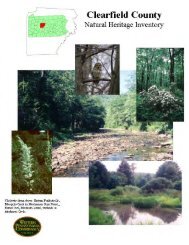Rice Cutgrass – Bulrush Vernal Pool System - Pennsylvania Natural ...
Rice Cutgrass – Bulrush Vernal Pool System - Pennsylvania Natural ...
Rice Cutgrass – Bulrush Vernal Pool System - Pennsylvania Natural ...
You also want an ePaper? Increase the reach of your titles
YUMPU automatically turns print PDFs into web optimized ePapers that Google loves.
and exhibit somewhat poorly defined boundaries. Shrub species typically are more prevalent in the<br />
Wool-grass <strong>–</strong> Mannagrass Mixed Shrub Marsh type than in the <strong>Rice</strong> cutgrass <strong>–</strong> <strong>Bulrush</strong> Marsh.<br />
Fike Crosswalk<br />
Related to Herbaceous <strong>Vernal</strong> <strong>Pool</strong>. This type is new to the <strong>Pennsylvania</strong> Plant Community Classification<br />
developed fromstudies of vernal pool ecosystems of <strong>Pennsylvania</strong>.<br />
Conservation Value<br />
<strong>Vernal</strong> pools are primarily found in forested areas and are characterized by absence of fish, lack of<br />
flowing water, small size, shallow depth, and presence of plants and animals that can withstand a period<br />
of drought (Brown and Jung 2005). Their seasonal nature is important because it excludes fish that<br />
would otherwise prey upon the eggs and larvae of amphibians breeding in them.<br />
In the mid-Atlantic states, 26 percent of all state-listed threatened and endangered amphibians are<br />
dependent on vernal pools.<br />
<strong>Vernal</strong> pools provide critical breeding habitat for several species of amphibians and a type of crustacean<br />
that use vernal pools almost exclusively during some stage of their life cycle. The amphibian species are:<br />
Marbled Salamander (Ambystoma opacum)<br />
Spotted Salamander (Ambystoma maculatum)<br />
Jefferson Salamander (Ambystoma jeffersonianum)<br />
Wood Frog (Rana sylvatica)<br />
Eastern Spadefoot (Scaphiopus holbrookii holbrookii)<br />
Springtime Fairy Shrimp (Eubranchipus vernalis).<br />
A plant species found only in vernal pools in <strong>Pennsylvania</strong> is the northeastern bulrush (Scirpus<br />
ancistrochaetus).<br />
Threats<br />
Threats include habitat fragmentation, alteration of hydrology and water chemistry, alteration of<br />
substrate, loss of vegetation, and global climate change.<br />
Filling vernal pools, and disturbances to the vegetation and soil around pools from building and road<br />
construction, quarries, and logging operations lead to direct mortality of animals and habitat destruction<br />
or degradation. <strong>Vernal</strong> pools are often not identified as wetlands due to their temporary nature.<br />
Clearing and development of adjacent land can lead to accumulation of agricultural run-off and<br />
pollution, sedimentation, and pollution in the pools. Removal or change in composition of vegetation in<br />
and around a pool affects which species can use the pool. For species that lay their eggs in plant










